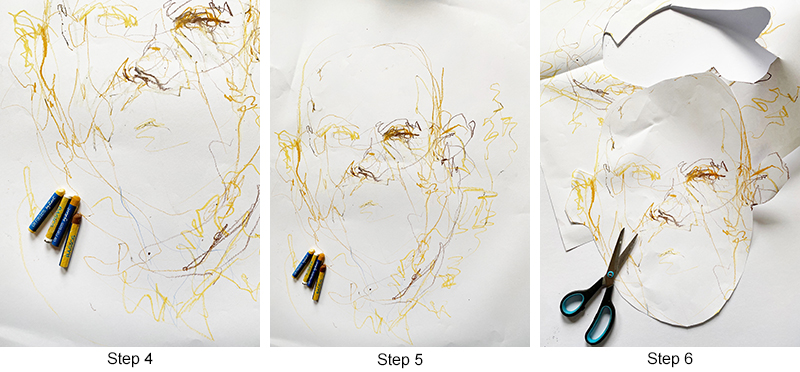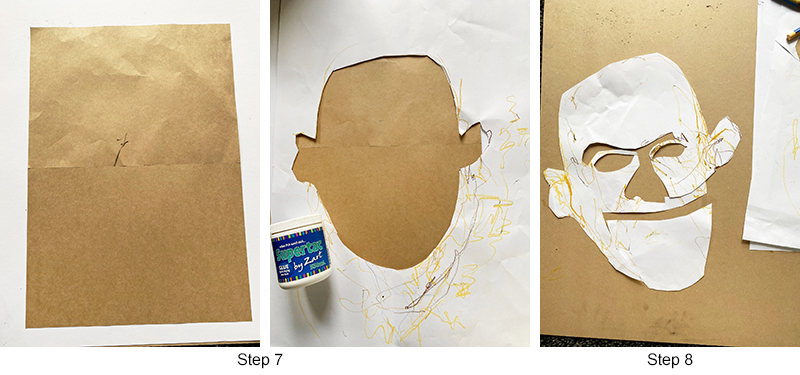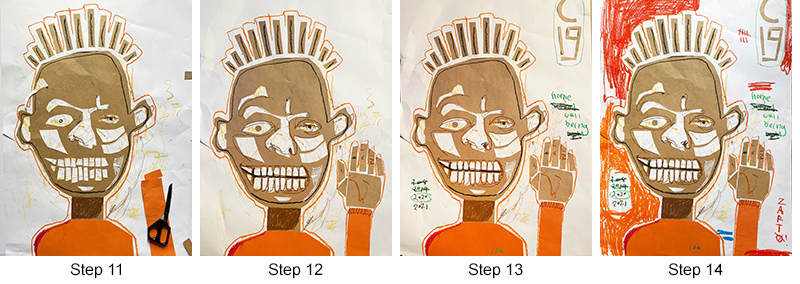Hey Hey, It’s Basquiat! (Self Portraits)
Year Levels: 5 – 8
with Nic Plowman

Click Here to download Lesson Plan
Overview
In this lesson, students will create a mixed media self-portrait collage based on the work of American artist and cultural icon, Jean Michel Basquiat.
Art Elements & Principles
Line, shape, texture, Colour, Contrast
Vocabulary
What do these words mean?
Painting, Graffiti, Street Art, Tag, Poet, Dichotomy
Cross-Curriculum / Capabilities Links
Music, Personal and Social Capabilities
Learning Objectives
Students will:
Explore the work of Jean-Michel Basquiat as inspiration to explore materials and develop individual responses to the ideas explored in his artworks
Experiment with art materials and mixed media techniques.
Create a self-portrait and discuss their ideas behind the work.
Be able to identify and describe the features of Jean-Michel Basquiat’s work.
Make
Create Artwork
Step 1: View the NGV Basquiat/Haring show online.
Take note of the work by Jean-Michel Basquiat; In particular the painting of people, heads and faces.
Step 2: Now pop on some music! (Always a great way to start any art activity)
*For this activity I suggest Jazz music. Basquiat loved Jazz music.
Step 3: Grab three different coloured oil pastels. Choose colours that you like or colours that represent how you are feeling.
Put these in your non-dominant hand (that means the hand you DON’T usually draw with)
Now sit in front of your piece of paper and look at the size of the paper. Work big and try to fill up most of the space with your drawing.
Take one of the oil pastels and close your eyes.

Step 4: Keeping your eyes closed, listen to the music and let yourself react to the music as you draw. You are drawing yourself, your own face.
To help with this use the hand you are not drawing with to gently feel your face. When you feel your eyebrow – draw your eyebrow; when you feel your nose – you’re your nose.
Feeling with one hand and drawing with the other.
Concentrate on the music, how does it make you feel? Let the music help move your hand and influence the marks you make.
Swap oil pastels when you feel like it. You can make whatever marks you like – listen to the music it will help you decide. Just remember you need to draw your face: some eyes, a nose, ears, mouth and a big round head to fit them in. Try to draw for five minutes, and try not to forget any part of your face.
Step 5: Open your eyes. It will look strange and scribbly and you will probably laugh – all these are good!
Step 6: Cut out the head shape drawing and put it aside. Keep the piece of paper with the hole in it (where your head drawing used to be) You will use it soon.

Step 7: Get a large coloured piece of paper (in the image I have used two pieces joined on the back with masking tape)
Place the piece of paper with the missing head shape (from step 6) on top and glue it down to the coloured paper.
Step 8: Cut out all the parts of your face: Eyes, eyebrows, nose, mouth and ears.

Step 9: Glue down all the parts of your face that you just cut out.
Step 10: To create a mouth, take the mouth you cut out (or a separate scrap piece of paper) and cut out lots of small rectangles for teeth. Like a happy smiling skull.
Glue all the face parts down: eyes, the nose, the teeth, etc
Step 11: Use some scraps to add hair and clothes. You can choose whatever colour paper you want or use pieces of scrap paper. Magazines or newspaper work too.
Step 12a: Choose a dark or light-coloured oil pastel (It needs to stand out from the background coloured paper) to draw a line around the outside and on the inside of your portrait. See example.
Step 12b: Then, using a continuous line (that means use one long one line where your oil pastel is always touching the paper as you draw). Draw around all the face parts you glued down: eyes, nose, teeth etc..
See image.
Step 13: Now you can add other elements like arms, hands and bodies.
Add some text from outcomes of *Activity A in the DISCUSSION part of this lesson.
Step 14: Paint or fill in the space around your portrait.
You can use the music to help you choose colours and make marks with this final step.
Like Basquiat, you are creating work that explores the dichotomy of experience.
You have used music to transform internal feelings into experimental mark making.
You have worked on a self-portrait that refers to what you look like and what you think and believe – referencing your mind/body connection.

Discussion / Reflection
Jean-Michel Basquiat was a famous American artist of Puerto Rican and Haitian heritage.
He was born in 1960 and died in 1988. Andy Warhol was his friend and supporter, and championed his career form the beginning. Basquiat started his career as a street poet and graffiti writer under the tag ‘SAMO’ with his friend Al Diaz. Basquiat’s work often referenced the dichotomies of human experience, social and societal values, and the inner and outer experience of being human.
Activity A: Word association.
Basquiat’s work often included text in his work that spoke of his inner experience and outer experience. This text often reflected dichotomies in thinking and values. (Dichotomy: things that are at opposite ends of a scale or seem vastly different) Eg. Home and Work, Health and Sickness, Rich and Poor, Light and Dark, Happy and Sad, Peanut Butter and Vegemite.
- Think of and recognise things in your life that are opposites? Things that cause different emotions and feelings?
- Make a list of things that you agree with and disagree with or things that make you happy or sad?
- Think of a situation that was challenging. Eg. Being stuck at home during Covid19 restrictions. What words describe both the positive and negatives aspects of this situation?
Pick some of the words you came up with to write on your self-portrait. Basquiat often wrote words on his work that he scribbled out or changed – Why do you think he did this?
*Basquiat used to sign his thoughts by writing SAMO – Do you have a nickname or a name you like? Sign your work with this.
Activity B: Art discussion. (After viewing the work of Basquiat)
Instruct students to work in pairs and perform a role play. Using a prop telephone (old 80’s phone to be authentic to Basquiat’s time) students will discuss a sample Basquiat artwork (that you have chosen for them to discuss). One student is a rich New York art buyer and the other Mary Boone the famous gallery owner who represented Basquiat and sold his work. Encourage students to use art language where possible (elements and principles)
Suggested questions:
What type of work is it?
Who is the artist?
Tell me about the artist’s work?
Can you describe it using art language please?
Describe the marks, colours and materials used.
How big is it? Where will you hang it?
Materials & Equipment
- Oil Pastels
- A3 Paper
- A3 Brown Kraft Paper or Card
- Glue stick
- Scissors
- A4/A3 Colour Paper
Don’t have these materials at home?
Click Here to view recommended materials
Inspiration
Related Artwork, Links & Sources
Share Your Outcomes!
How did you go!? We’d love you to share your artwork with us on Facebook or Instagram!
#zartart

